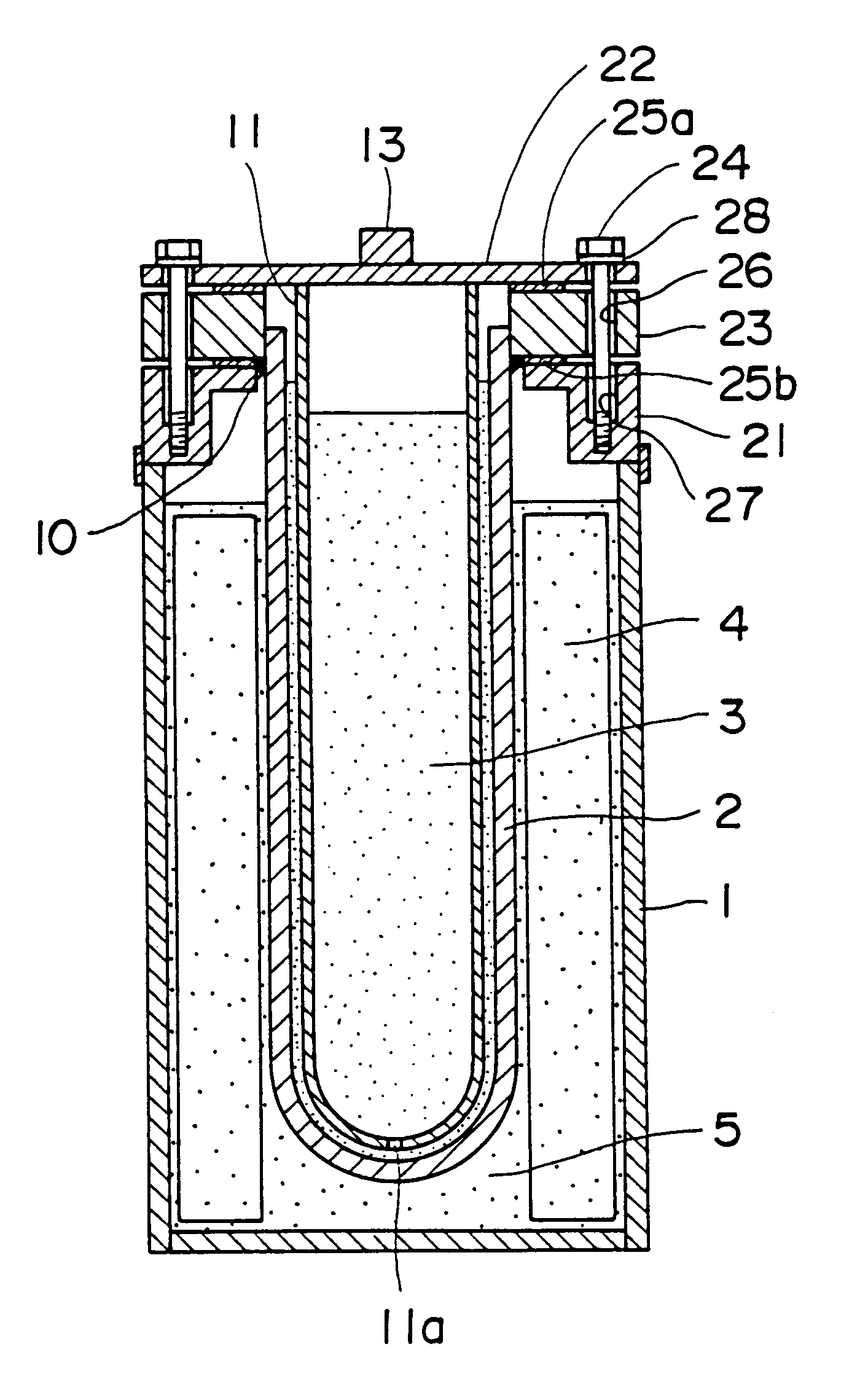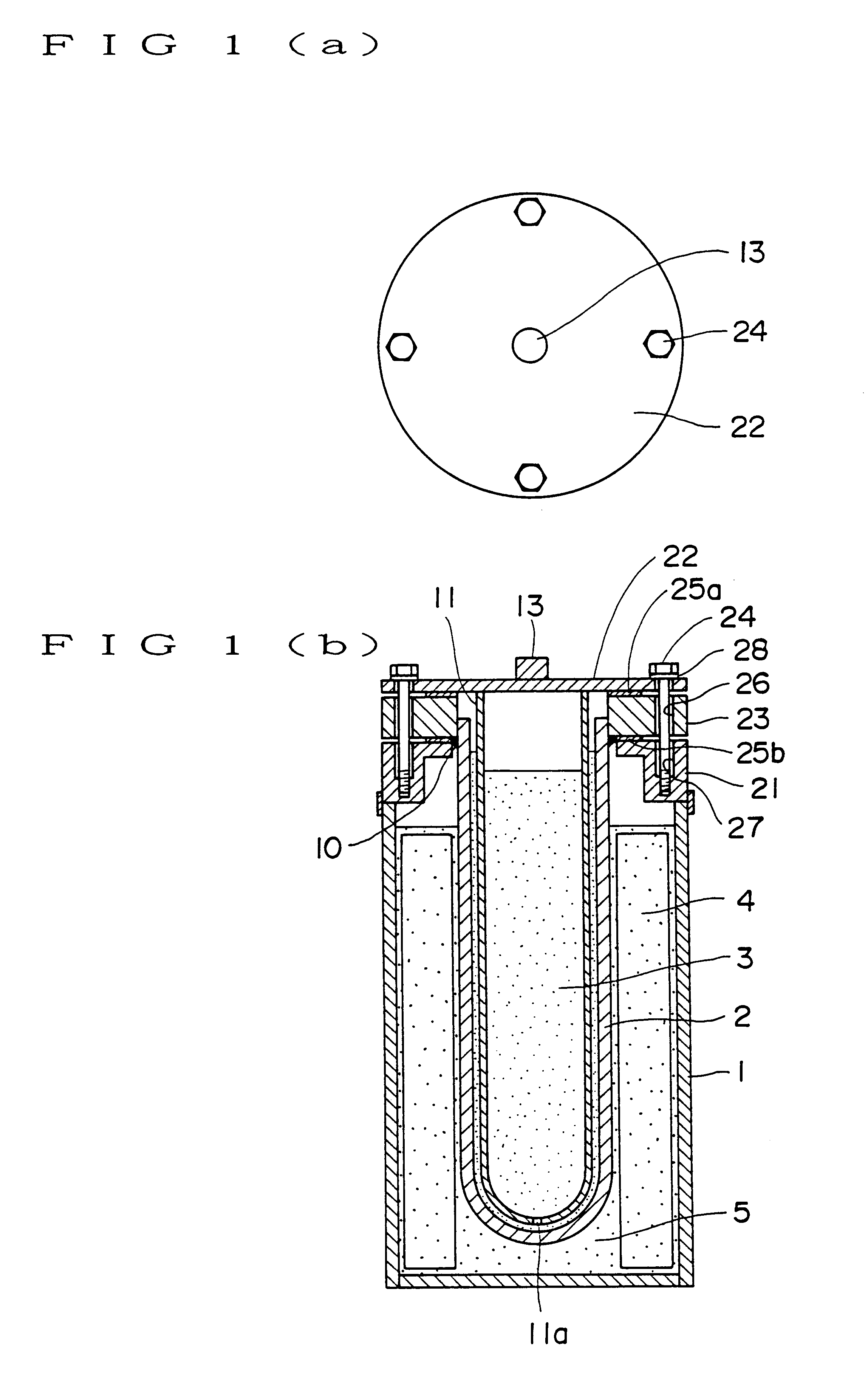Sodium secondary battery
- Summary
- Abstract
- Description
- Claims
- Application Information
AI Technical Summary
Benefits of technology
Problems solved by technology
Method used
Image
Examples
embodiment 1
FIG. 1A and FIG. 1B are a schematic illustration of a sodium secondary battery according to a first embodiment of the present invention.
As shown in FIG. 1A and FIG. 1B, the sodium secondary battery, according to the first embodiment of the present invention, has a structure the same per se as that of the conventional secondary battery, as shown in FIG. 9, but has an outer case sealed with a cover in a different manner to provide improved sealing of the battery.
The sodium secondary battery, according to the first embodiment of the present invention, has a negative electrode chamber formed by placing sodium 3 into a bottom-closed, hollow cylindrical solid electrolyte 2 provided inside an outer case 1. A positive electrode chamber, which houses a porous electrode 4 impregnated with sulfur 5, serving as a positive electrode active substance is provided, between the outer case 1 and the solid electrolyte 2. A cover 22, which closes an outer case metal fitting 21 provided for the opening ...
embodiment 2
FIG. 3 is a schematic illustration of a plate-type sodium secondary battery according to a second embodiment of the present invention.
As shown in FIG. 3, the sodium secondary battery, according to the second embodiment of the present invention, includes a negative electrode chamber in which sodium 31 is placed, a positive electrode chamber which houses a porous electrode 32 impregnated with sulfur 33, and a plate-like solid electrolyte 30 interposed therebetween. The negative electrode chamber is defined by a negative electrode container 35 having an outwardly projecting flange 34 and the positive electrode chamber is defined by a positive electrode container 37 having an outwardly projecting flange 36, and the negative and positive electrode containers 35 and 37 are located opposite to each other with respect to the solid electrolyte 30. An insulator 38 is provided along the periphery of the solid electrolyte 30, and the outwardly projecting flange 34 of the negative electrode and ...
embodiment 3
FIG. 7 is a schematic illustration of a sodium secondary battery according to a third embodiment of the present invention.
As shown in FIG. 7, the sodium secondary battery, according to the third embodiment, has a battery structure the same per se as that shown in FIG. 1A and FIG. 1B, but provides improved sealing due to the employment of a different fastening manner of a cover and a case. Briefly, an outer case 1 is fastened to a cover 22 by bolts and nuts, with the bolts being arranged so as not to penetrate an insulator, to thereby provide improved sealing.
The sodium secondary battery according to the third embodiment has a negative electrode chamber formed by placing sodium 3 into a bottom-closed, hollow cylindrical solid electrolyte 2 provided inside an outer case 1. A positive electrode chamber, which houses a porous electrode 4 impregnated with sulfur 5 serving as a positive electrode active substance is provided between the outer case 1 and the solid electrolyte 2. A cover 22...
PUM
 Login to View More
Login to View More Abstract
Description
Claims
Application Information
 Login to View More
Login to View More - R&D
- Intellectual Property
- Life Sciences
- Materials
- Tech Scout
- Unparalleled Data Quality
- Higher Quality Content
- 60% Fewer Hallucinations
Browse by: Latest US Patents, China's latest patents, Technical Efficacy Thesaurus, Application Domain, Technology Topic, Popular Technical Reports.
© 2025 PatSnap. All rights reserved.Legal|Privacy policy|Modern Slavery Act Transparency Statement|Sitemap|About US| Contact US: help@patsnap.com



